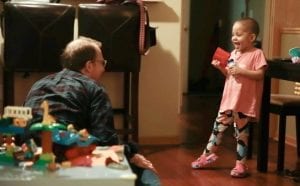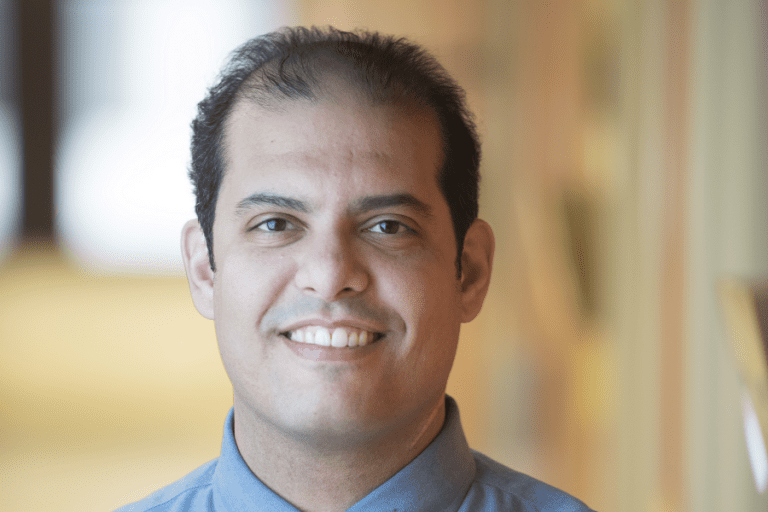Three-year-old Lily, talkative and full of energy, runs around her living room pointing out her many toys and stuffed animals in her warm home on a chilly evening in November.
“Daddy, I found Doctor Jessie’s hat!” she shouts, while holding up her Jessie doll from Toy Story.
“She has her dad wrapped around her finger,” says Donna, Lily’s mom, with a smile.
Between each toy, Lily makes sure to give a gentle pat to her family’s two cats, Cody and Sesame, or scoot around the room on her red tricycle. The scar from the port on her chest and her short, wispy hair are the only visible signs of the intense treatment she has been through to fight the leukemia cells multiplying inside her little body.
The Beginning - Leukemia
In Fall 2018, Lily was living the life of a normal toddler, playing with Donna and video chatting with her dad, Nick, who was working in Europe at the time. The first sign something was wrong was when the usually bubbly Lily was too tired to video chat with her dad.

Lily plays with her dad, Nick, in the family's living room.
“I was just so taken aback, because that never happened,” Nick said. “She was lying on the couch and was just like no, I’m too tired, I don’t want to talk to you right now. That seemed really off for her.”
Donna took Lily to the doctor, who suspected flu but urged them to go to emergency room to do a blood count as a precaution because Lily was in a lot of pain. The counts came back abnormal and doctors ran additional tests and confirmed Lily had leukemia. Donna called Nick, who immediately booked a flight home.
“She was admitted to the hospital on a Thursday night, and it was late Friday night before I was able to get back and see her,” Nick said. “I had a 10-hour flight to dwell on it without any real information… that was really difficult.”
Just three days later, on Nick’s birthday, Lily started aggressive chemotherapy treatments. Doctors confirmed she had a particularly aggressive type of acute myeloid leukemia (AML) that requires high-intensity chemotherapy to treat. For each round of chemo, Lily was in the hospital, unable to leave her room for weeks at a time. During her last in-patient treatment, her bone marrow was damaged to the point where it could no longer produce healthy blood cells and she was discharged after being confined to her room for 57 days.
Her family tried to make each hospital room feel like home for her with Paw Patrol posters, balloons above her bed and daily visits from both sets of grandparents, but each day held things that no 3-year-old should have to endure. No matter what she’s been asked to go through, Lily has never protested or complained.
“I’m really proud and amazed by her resilience,” Donna said. “Lily has endured multiple rounds of high intensity chemotherapy treatments to treat her disease. She never complains about the trauma she’s suffered. Lily is active and playful even when fighting terrible pain, nausea, fatigue and other effects from the treatments. It really puts things in perspective to see her stop in the middle of playing to ask for a bucket to throw up, and then just carry on playing. If I get sick, I can’t do that.”
Heartbreaking News
As resilient as Lily has been, her cancer has been resilient, too. Just two and a half months after Lily’s bone marrow transplant, she relapsed – a clear sign that her type of cancer is stronger than what today’s medicines know how to fight. Doctors tried novel targeted therapies and a clinical trial, but Lily was unable to achieve sustained remission. When her bone marrow ultimately failed to regenerate, doctors told Donna and Nick that it was time to take Lily home and enter palliative care. They were devastated.
“At first, I felt very hopeless. I felt like they were giving up on her. I was thinking, ‘I don’t understand why you don’t think there’s something else we can try,” Donna said. “But one of the doctors said to me, even though we’re taking her home, the medical team will still treat her and care deeply about her. I think that gave me a sense of relief to know that we’re not just walking out the door and waiting until the end. The trust and respect we’ve built with them from the beginning was so important in that moment. When they show me how much they care about her, it gives me a sense of hope and a feeling that we’re not alone.”
Donna and Nick are facing the prospect of losing their daughter to cancer with unimaginable strength. It’s hard for them to see her so energetic and happy when they know she’s still so sick, and it won’t be this way for much longer. Their ultimate goal now is to spend as much time with Lily as they can and make every day special for her while she’s feeling well. Nick says that in some way, knowing that their time is limited has given him a chance to make that time truly count.
“One thing I’ve tried to tell myself throughout all this is that many kids who die young die in accidents or something sudden. And as horrible as this process is, if there’s some small silver lining, it’s that we’ve had the opportunity this past year to spend every single day with our child,” Nick said. “I’ve had the chance to tell her that I love her and show her I love her. I don’t know if that makes it harder or easier, but I just think about parents who, their child is just gone and they don’t have that opportunity. Nobody should have to go through losing a child, but I have to think that somehow, this has to be a little bit better.”
Between Hope and Grief
Living in the messy space between hope and grief has given Donna and Nick a different perspective on nearly everything – life, work and parenting. They have a deep appreciation for everyone who has done their part to make things easier for their family since Lily’s diagnosis.
Nick’s and Donna’s work supervisors told them not to worry about work and to take as much time as they need. Nurses printed out Paw Patrol characters to add to the decorations in Lily’s room. The security team at the hospital acts like family, warmly greeting Lily’s grandparents whenever they come to visit. The love they’ve received during their darkest times makes them want to use Lily’s story to give back.
“Everyone is incredible. From the doctors, nurses, therapists, child life family specialists and the people that cleaned our room every day, they together created a phenomenal support system for every patient and their families,” Donna said. “We’ve met more people whose children are sick than we ever wanted to know, and we want to help.”
Donna says she wants Lily’s story told in a way that reflects their real-life experience, and honestly shows the pain of a family facing a devastating outcome. It’s true that there are more cancer survivors today than ever before, but doctors and researchers are still far from being able to provide long, healthy lives to every child diagnosed with cancer. Donna wants to share Lily’s story to make sure people know – we’re not there yet.
“I want something good to come from it all,” Donna said. “At the end of the day, I don’t want to just put together a funeral and that’s it. We want her life to mean something. We’re sending her blood to researchers so they can understand this kind of leukemia better, and we’re sharing her story so others can see what it’s like… It’s hard to know what else we can do, but we want to make her fight worth it.”
Update: Lily was admitted to the hospital for the last time on December 19, 2019. On January 7, 2020, she passed away, surrounded by her parents and family. Please click here to visit Lily's memorial page.




